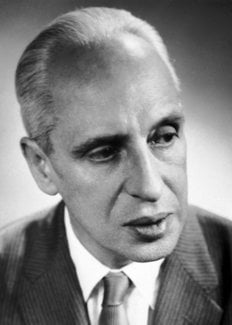Severo Ochoa
Biographical

Severo Ochoa was born at Luarca, Spain, on September 24th, 1905. He is the son of Severo Ochoa, a lawyer and business man, and Carmen de Albornoz.
Ochoa was educated at Málaga College, where he took his B.A. degree in 1921.* His interest in biology was greatly stimulated by the publications of the great Spanish neurologist, Ramón y Cajal, and he went to the Medical School of the University of Madrid, where he obtained his M.D. degree (with honours) in 1929. While he was at the University he was Assistant to Professor Juan Negrin and he paid, during the summer of 1927, a visit to the University of Glasgow to work under Professor D. Noel Paton.
After graduating in 1929 Ochoa went, with the aid of the Spanish Council of Scientific Research, to work under Otto Meyerhof at the Kaiser Wilhelm Institut für Medizinische Forschung at Heidelberg. During this period he worked on the biochemistry and physiology of muscle, and his outlook and training were decisively influenced by Meyerhof.
In 1931, Ochoa was appointed Lecturer in Physiology at the University of Madrid, a post he held until 1935. In 1932 he went to the National Institute for Medical Research, London, where he worked with Dr. H. W. Dudley on his first problem in enzymology.
Returning to Madrid in 1934, he was appointed Lecturer in Physiology and Biochemistry there and later became Head of the Physiology Division of the Institute for Medical Research, Madrid. In 1936 he was appointed Guest Research Assistant in Meyerhof’s Laboratory at Heidelberg, where he worked on some of the enzymatic steps of glycolysis and fermentation. In 1937 he held a Ray Lankester Investigatorship at the Plymouth Marine Biological Laboratory and from 1938 until 1941 he worked on the biological function of vitamin B1 with Professor R. A. Peters at Oxford University, where he was appointed Demonstrator and Nuffield Research Assistant.
While he was at Oxford he became interested in the enzymatic mechanisms of oxidative metabolism and in 1941 he went to America and worked, until 1942, at the Washington University School of Medicine, St. Louis, where he was appointed Instructor and Research Associate in Pharmacology and worked with Carl and Gerty Cori on problems of enzymology. In 1942 he was appointed Research Associate in Medicine at the New York University School of Medicine and there subsequently became Assistant Professor of Biochemistry (1945), Professor of Pharmacology (1946), Professor of Biochemistry (1954), and Chairman of the Department of Biochemistry. In 1956 he became an American citizen.
Ochoa’s research has dealt mainly with enzymatic processes in biological oxidation and synthesis and the transfer of energy. It has contributed much to the knowledge of the basic steps in the metabolism of carbohydrates and fatty acids, the utilization of carbon dioxide, and the biosynthesis of nucleic acids. It has included the biological functions of vitamin B1, oxidative phosphorylation, the reductive carboxylation of ketoglutaric and pyruvic acids, the photochemical reduction of pyridine nucleotides in photosynthesis, condensing enzyme – which is the key enzyme of the Krebs citric acid cycle, polynucleotide phosphorylase and the genetic code.
Ochoa holds honorary degrees of the Universities of St. Louis (Washington University), Glasgow, Oxford, Salamanca, Brazil, and the Wesleyan University. He is Honorary Professor of the University of San Marcos, Lima, Peru. He was awarded the Neuberg Medal in Biochemistry in 1951, the Medal of the Société de Chimie Biologique in 1959, and the Medal of New York University in the same year. He is a member of several learned societies in the U.S.A., Germany, Japan, Argentina, Uruguay, and Chile, and President of the International Union of Biochemistry.
In 1931 Ochoa married Carmen Garcia Cobian.
*According to other sources, Severo Ochoa graduated from high school at the Instituto de Bachillerato de Málaga in 1921.
This autobiography/biography was written at the time of the award and first published in the book series Les Prix Nobel. It was later edited and republished in Nobel Lectures. To cite this document, always state the source as shown above.
Severo Ochoa died on November 1, 1993.
Nobel Prizes and laureates
Six prizes were awarded for achievements that have conferred the greatest benefit to humankind. The 14 laureates' work and discoveries range from quantum tunnelling to promoting democratic rights.
See them all presented here.
